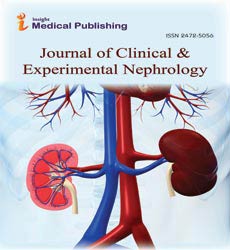Mineral Metabolism: The BodyâÂÂs Essential Process for Cellular Function
Zichen Runchu
Department of Pharmacy, Quanzhou First Hospital Affiliated to Fujian Medical University, Quanzhou, China
Published Date: 2024-12-12DOI10.36648/2472-5056.9.6.289
Zichen Runchu*
1Department of Pharmacy, Quanzhou First Hospital Affiliated to Fujian Medical University, Quanzhou, China
- *Corresponding Author:
- Zichen Runchu,
Department of Pharmacy, Quanzhou First Hospital Affiliated to Fujian Medical University, Quanzhou, China
E-mail: runchuzichen@qu.cn
Received date: November 27, 2024, Manuscript No. IPJCEN-24-19998; Editor assigned date: November 30, 2024, PreQC No. IPJCEN-24-19998 (PQ); Reviewed date: December 13, 2024, QC No. IPJCEN-24-19998; Revised date: December 20, 2024, Manuscript No. IPJCEN-24-19998 (R); Published date: December 27, 2024, DOI: 10.36648/2472-5056.9.6.289
Citation: Runchu Z (2024) Mineral Metabolism: The Body’s Essential Process for Cellular Function. J Clin Exp Nephrol Vol.9 No.6: 289.
Description
Mineral metabolism refers to the processes through which the body regulates and maintains the levels of essential minerals required for its physiological functions. Minerals such as calcium, phosphorus, magnesium, sodium, potassium and trace elements like zinc and iron play vital roles in cellular function, structural integrity, enzymatic activities and maintaining the body's homeostasis. Understanding mineral metabolism is fundamental for comprehending numerous biochemical pathways and clinical disorders.
Gastrointestinal absorption: Minerals are absorbed in the gastrointestinal tract, primarily the small intestine. Vitamin D improves the absorption of calcium and phosphate, while dietary composition and gut health influence the bioavailability of various minerals.
Bone reservoir: Bones act as a reservoir for calcium and phosphorus. Osteoclasts and osteoblasts mediate the release and deposition of these minerals, respectively, under the influence of hormones like Parathyroid Hormone (PTH) and calcitriol.
Renal excretion and reabsorption: The kidneys regulate mineral excretion and reabsorption to maintain serum levels within physiological ranges. For example, in response to hypocalcemia, PTH stimulates calcium reabsorption in the renal tubules while promoting phosphate excretion.
Essential minerals and their functions
Calcium: Calcium is a vital mineral primarily stored in bones and teeth, constituting about 99% of the body's total calcium content. It plays a central role in skeletal structure, muscle contraction, blood clotting and nerve impulse transmission. The body tightly regulates calcium levels through the interplay of hormones like Parathyroid Hormone (PTH), calcitriol (active vitamin D) and calcitonin.
Phosphorus: An integral component of bones, teeth and cellular membranes, phosphorus is predominantly present as phosphate ions. It is essential for energy metabolism, particularly in the formation of Adenosine Triphosphate (ATP) and contributes to DNA and RNA synthesis.
Magnesium: Magnesium is involved in over 300 enzymatic reactions, including protein synthesis, muscle function and glucose metabolism. It also stabilizes the structural framework of nucleic acids and ribosomes.
Sodium and potassium: These electrolytes are critical for maintaining cellular membrane potential, fluid balance and nerve signal conduction. Sodium operates predominantly in extracellular fluid, whereas potassium is largely intracellular.
Trace elements: Zinc, iron, copper and selenium are trace minerals that, despite being required in smaller quantities, are vital for enzymatic functions, immune responses and antioxidant defense systems.
Disorders of mineral metabolism
Disruptions in mineral metabolism can lead to a range of pathological conditions.
Hypocalcemia and hypercalcemia: Low calcium levels (hypocalcemia) can result in muscle cramps, tetany and cardiac arrhythmias, whereas high levels (hypercalcemia) can cause kidney stones, bone pain and neurological symptoms.
Osteoporosis: A condition characterized by decreased bone mass and density, osteoporosis often results from prolonged calcium and vitamin D deficiencies or hormonal imbalances.
Hyperphosphatemia and hypophosphatemia: Excess phosphorus (hyperphosphatemia) is commonly associated with Chronic Kidney Disease (CKD) and can exacerbate vascular calcification. Conversely, hypophosphatemia can impair energy metabolism and muscle function.
Magnesium disorders: Hypomagnesemia is linked to cardiovascular issues and neuromuscular dysfunction, while hypermagnesemia, though rare, can occur in kidney failure and lead to toxicity.
Electrolyte imbalances: Dysregulation of sodium and potassium levels can cause severe complications, including hypertension, cardiac arrhythmias and neurological disturbances.
Mineral metabolism in clinical practice: Understanding mineral metabolism is particularly vital in nephrology and endocrinology. In CKD, mineral dysregulation is a hallmark, with patients frequently exhibiting abnormalities in calcium, phosphorus and PTH levels. This condition, termed Chronic Kidney Disease-Mineral and Bone Disorder (CKD-MBD), significantly increases the risk of cardiovascular disease and fractures.
Management strategies for CKD-MBD involve dietary phosphate restriction, phosphate binders, vitamin D analogs and calcimimetics to address hyperparathyroidism. Similarly, addressing mineral deficiencies or excesses in other clinical settings often requires a tailored approach, considering the underlying cause and patient-specific factors.
Conclusion
Mineral metabolism is a fundamental of human physiology, influencing numerous biochemical and structural processes. The intricate balance maintained through hormonal regulation and organ function underscores the body's remarkable ability to adapt and sustain homeostasis. However, disruptions in this balance can have far-reaching implications, emphasizing the importance of ongoing research and targeted interventions in both preventive and therapeutic settings. Recognizing the complexities of mineral metabolism allows for better diagnosis, management and improved patient outcomes in various medical conditions.
Open Access Journals
- Aquaculture & Veterinary Science
- Chemistry & Chemical Sciences
- Clinical Sciences
- Engineering
- General Science
- Genetics & Molecular Biology
- Health Care & Nursing
- Immunology & Microbiology
- Materials Science
- Mathematics & Physics
- Medical Sciences
- Neurology & Psychiatry
- Oncology & Cancer Science
- Pharmaceutical Sciences
